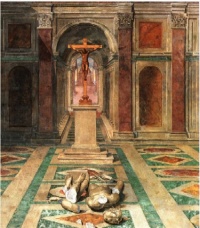Crucifixion of Jesus
From The Art and Popular Culture Encyclopedia

|
Related e |
|
Featured: |
The crucifixion of Jesus is an event recorded in all four gospels which takes place after his arrest and trial and includes his scourging, crucifixion on the cross, and burial. In Christian theology, the death of Jesus by crucifixion is a core event on which much teaching depends, representing a critical aspect of the doctrine of salvation, portraying the suffering and death of the Messiah as necessary for the forgiveness of sins. According to the New Testament, Jesus was resurrected after three days and appeared to his disciples over a 40-day period before ascending to heaven.
Crucifixion in art, symbolism and devotions
Since the crucifixion of Jesus, the cross has become a key element of Christian symbolism, and the crucifixion scene has been a key element of Christian art, giving rise to specific artistic themes such as Ecce Homo, The Raising of the Cross, Descent from the Cross and Entombment of Christ.
The Crucifixion, seen from the Cross by Tissot presented a novel approach at the end of the 19th century, in which the crucifixion scene was portrayed from the perspective of Jesus.
The symbolism of the cross which is today one of the most widely recognized Christian symbols was used from the earliest Christian times and Justin Martyr who died in 165 describes it in a way that already implies its use as a symbol, although the crucifix appeared later. Masters such as Caravaggio, Rubens and Titian have all depicted the Crucifixion scene in their works.
Devotions based on the process of crucifixion, and the sufferings of Jesus are followed by various Christians. The Stations of the Cross follows a number of stages based on the stages involved in the crucifixion of Jesus, while the Rosary of the Holy Wounds is used to meditate on the wounds of Jesus as part of the crucifixion .
The presence of the Virgin Mary under the cross has in itself been the subject of Marian art, and well known Catholic symbolism such as the Miraculous Medal and Pope John Paul II's Coat of Arms bearing a Marian Cross. And a number of Marian devotions also involve the presence of the Virgin Mary in Calvary, e.g., Pope John Paul II stated that "Mary was united to Jesus on the Cross". Well known works of Christian art by masters such as Raphael (e.g., the Mond Crucifixion), and Caravaggio (e.g., his Entombment) depict the Virgin Mary as part of the crucifixion scene.
See also
- Acts of Reparation
- Atonement in Christianity
- Crucifixion in the arts
- Dispute about Jesus' execution method
- Descent from the Cross
- Passion (Christianity)
- Seven Sorrows of Mary
- Swoon hypothesis

